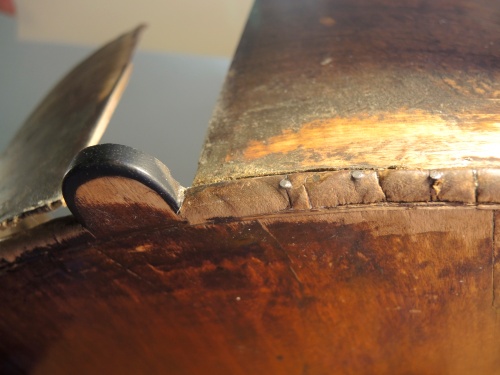At one end of the spectrum is the mixed metaphor – relatively harmless, but wrong. At the other end is the potentially deadly* mix of seemingly tame cleaning agents found under many a kitchen sink – ammonia and chlorine. The back story here is that when I was in fourth grade (ancient history, I know), a classmate of mine’s brother landed himself in the hospital, having torched his respiratory system, and not by spouting mixed metaphors.
Somewhere in the middle of the spectrum lies the conventional wisdom, luthier version, that if you introduce a metal structural element into the wood and glue universe of the violin, you are asking for complications, eventually. There are inconvenient exceptions, of course, but as far as I know, they appear only rarely in the context of making. Violin making, that is.
As far as restoration goes, screws, nails, metal anything – big no no. For one thing, we don’t want to disrupt the synergy between various parts of an instrument by relying on a material, so radically different, that it won’t move with the wood. Secondly, it’s hell when you hit a screw with the chisel you just honed to a razor edge.
Recently, a project came to me that might have been a straightforward neck and button graft. Is there something on that Restorer’s Mind page about “a never ending stream of firsts”? I may have to edit, if not. This 18c Testore family cello had at some point had full edging replacements, top and back, attached all around with glue and small nails. It’s possible that purfling (characteristically only etched in) was added to disguise the joint. When I began this project, the neck was broken, the button compromised and the upper back edges were a mess.

When I started removing deteriorated wood, this is what was left! I found it useful to go exploring with a magnet, before committing my nicely sharpened tools to wood.

It might not be possible to know the circumstances that resulted in this odd and unlikely wedding of wood and metal elements. The edges were not underlaid, but simply glued and nailed with the aid of some judicious kerfing on the interiors of the more extreme curves. When? Long enough ago for the upper back edges to deteriorate dramatically.
I replaced those edges with new wood underlaid into the back in a manner that would preempt the need for additional, need I say, nefarious reinforcement. Much more comfortable for the player, I should think, and easier on the sweater, too!










*I do not, in fact, know if this chemical combo is deadly. But to the 9 year old brain, it was a sensible conclusion.
And about the nails, there are plenty left in the c bouts, and the lower bouts to provide many years of puzzlement and consternation to future restorers.
Nice work!! Is that the original button reattached on the added wood?
FYI – yes, bleach (NaOCl) plus ammonia NH3 is deadly. It reacts to form chlorine gas (Cl2), hydrochloric acid (HCl), and chloramine gas (NH2Cl) (with salt and water left over). It can also make explosive hydrazine (N2H2).
None of which are good to inhale or be exposed to.
Bleach and vinegar also make chlorine gas. Don’t do it.
Bleach and alcohol or acetone make chloroform. Don’t do that either.
Actually, just avoid bleach. It’s nasty stuff.
Thanks, Claire! The old button was not original either, so I replaced it along with the edges. Thanks, too, for the chem lesson. You are truly an amazing resource!
Wow! What a beautiful edge.